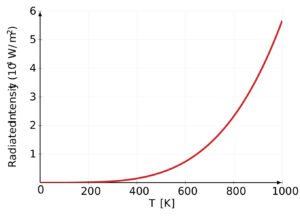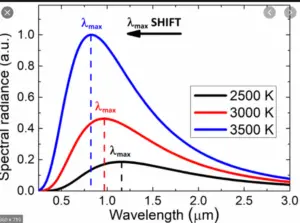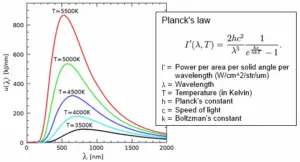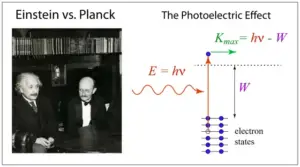In physics, a black body or blackbody refers to an idealized object that absorbs all electromagnetic radiation incident upon it, regardless of frequency or angle of incidence. and emits radiation at all wavelengths. The radiation emitted by a black body in thermal equilibrium with its environment is called black-body radiation. It is an essential concept in the study of thermal radiation and plays a crucial role in understanding the behavior of objects at different temperatures.

The term “black body” originated from the observation that an object that appears black at room temperature starts to glow and change color as it is heated. A perfect black body is an object that absorbs all electromagnetic radiation, regardless of its wavelength or frequency, without reflecting or transmitting any of it. Consequently, it emits radiation at all wavelengths and is an efficient energy radiator.
The name “black body” is given because it absorbs all colors of light, due to which it appears black. In contrast, a white body has a “rough surface that reflects all incident rays completely and uniformly in all directions.
The behavior of a black body is described by several fundamental principles, such as Planck’s law, Wein’s displacement law, and the Stefan-Boltzmann law.
An ideal black body in thermal equilibrium has two main properties:
- It is an ideal emitter: at every frequency, it emits as much or more thermal radiative energy as any other body at the same temperature.
- It is a diffuse emitter; measured per unit area perpendicular to the direction, the energy is radiated isotropically, independent of direction.
What is a black body? Definition
Black body definition: A black body is an idealized object that absorbs all electromagnetic radiation incident upon it, regardless of frequency or angle of incidence. and emits radiation at all wavelengths in all directions.
What is black body radiation?
The radiation emitted by a black body in thermal equilibrium with its environment is called black-body radiation.
Black body radiation refers to the thermal radiation emitted by a black body or an object that approximates the behavior of a black body. It is characterized by its spectral distribution and intensity, which depend solely on the temperature of the emitting object.
Black body radiation follows Planck’s law, which describes the spectral radiance (power per unit area per unit wavelength) emitted by a black body at a given temperature. According to Planck’s law, the intensity of radiation at each wavelength is determined by the temperature of the black body and follows a specific distribution curve.

The spectral distribution of black body radiation is continuous and spans a range of wavelengths. As the temperature of the black body increases, the peak of the distribution shifts to shorter wavelengths, leading to a change in the color of the emitted radiation. At low temperatures, the radiation appears predominantly in the infrared range, while at higher temperatures, it shifts to visible light and eventually to ultraviolet and higher-energy radiation.
The intensity of black body radiation at a specific temperature is also governed by the Stefan-Boltzmann law. This law states that the total power radiated per unit surface area of a black body is proportional to the fourth power of its absolute temperature. It quantifies the relationship between the temperature of a black body and the total energy it radiates.
Emissivity of the Black body and Real body
Emissivity is a property that characterizes the ability of a material to emit thermal radiation. It is defined as the ratio of the radiation emitted by a real material to the radiation emitted by a black body at the same temperature.
The emissivity of a material is a value between 0 and 1, where 0 represents a perfectly reflective material (does not emit radiation) and 1 represents a perfect black body (emits radiation as described by Planck’s law). Constructing black bodies with an emissivity as close to 1 as possible is currently a topic of interest.
Real materials have emissivities less than 1 because they do not absorb and emit radiation as efficiently as a black body. The emissivity of a material depends on its composition, surface properties, and the wavelength of the radiation being considered. Different materials have different spectral emissivity, meaning their emissivity may vary with wavelength. A source with a lower emissivity, independent of frequency, is often referred to as a gray body.
Materials with high reflectivity, such as polished metals, have low emissivities. They reflect a significant portion of the incident radiation and emit less thermal radiation. On the other hand, materials with rough surfaces or dark colors tend to have higher emissivities because they absorb and emit radiation more effectively.
Black body laws
There are three fundamental laws that describe the behavior of black bodies: Planck’s law, Wien’s displacement law, and the Stefan-Boltzmann law. These laws provide important insights into the spectral distribution, peak wavelength, and total power radiated by a black body at different temperatures.
Planck’s Law
Planck’s law describes the spectral distribution of radiation emitted by a black body at a given temperature. It states that the intensity of radiation emitted per unit wavelength and unit surface area of a black body is proportional to the rate of change of energy with respect to wavelength. Mathematically, it can be expressed as:
| $$B(\lambda, T) = \frac{2hc^2}{\lambda^5} \cdot \frac{1}{e^{\frac{hc}{\lambda kT}} – 1}$$ |
Where:
- $B(\lambda, T)$ represents the spectral radiance (power per unit area per unit wavelength)
- λ is the wavelength
- T is the temperature
- h is Planck’s constant
- c is the speed of light, and
- k is the Boltzmann constant
Planck’s law shows that the spectral radiance depends on temperature and wavelength. As the temperature increases, the peak of the spectral radiance shifts to shorter wavelengths, resulting in a change in the color of the emitted radiation.
Read Also:
Wien’s Displacement Law
Wien’s displacement law relates the wavelength at which the spectral radiance of a black body is at its maximum (peak wavelength) to its temperature. It states that the product of the peak wavelength $(\lambda_{max})$ and the temperature (T) of a black body is a constant. Mathematically, it can be expressed as: $$\lambda_{max} \times T = \text{constant}$$
This law implies that as the temperature of a black body increases, the wavelength at which it emits the most intense radiation becomes shorter.
Read Also:
Stefan-Boltzmann Law
The Stefan-Boltzmann law relates the total power radiated by a black body to its temperature. It states that the total energy radiated per unit surface area of a black body is proportional to the fourth power of its absolute temperature. Mathematically, it can be expressed as $$P = \sigma A T^4$$
Where:
- P is the total power radiated.
- σ is the Stefan-Boltzmann constant (approximately $5.67 \times 10^{-8}$ W/(m²K^4))
- A is the surface area of the black body, and
- T is its absolute temperature.
This law shows that the power radiated by a black body increases rapidly with temperature. It also indicates that a black body at a higher temperature emits radiation at a higher rate and across a wider range of wavelengths.
Read Also:
- Stefan-Boltzmann law: statement, constant & formula derivation
- Rayleigh-Jeans Law: statement, and formula derivation
Black body effect
The “black body effect” refers to the phenomenon where an object absorbs all incident radiation and emits radiation at all wavelengths according to its temperature. It is closely related to the concept of a black body.
When a material or object exhibits the black body effect, it means that it absorbs electromagnetic radiation across a wide range of wavelengths and does not reflect or transmit any significant amount of it. As a result, the object appears black, hence the term “black body.”

The black body effect is a consequence of the idealized behavior of a black body, which is an object that perfectly absorbs all incident radiation. While no real object can perfectly exhibit this behavior, certain materials or structures can approximate it to varying degrees. For example, a cavity with a small opening acts as a good approximation of a black body because the radiation entering the cavity is reflected multiple times, leading to effective absorption.
When a black body or an object exhibiting the black body effect is heated, it emits thermal radiation according to its temperature. This emission follows Planck’s law, which describes the spectral distribution of radiation emitted by a black body. The emitted radiation is continuous and spans a range of wavelengths, with the intensity peaking at a specific wavelength determined by the object’s temperature.
The black body effect has important implications in various fields of study, such as thermodynamics, astrophysics, and the design of radiation-based technologies. It provides a theoretical reference for understanding the behavior of objects in thermal equilibrium and plays a crucial role in the study of thermal radiation and energy transfer.
Black body properties
A black body is an idealized object in physics that possesses certain properties. Here are some important properties of a black body:
- Perfect Absorption: A black body is assumed to absorb all incident electromagnetic radiation across the entire spectrum without any reflection or transmission. It absorbs radiation of all wavelengths and does not reflect or transmit any of it.
- Perfect Emission: A black body is an ideal emitter of thermal radiation. It radiates energy at all wavelengths and in all directions. It emits radiation based on its temperature and follows the spectral distribution described by Planck’s law.
- Thermal Equilibrium: A black body is in thermal equilibrium with its surroundings. This means that the rate of absorption of radiation is equal to the rate of emission, resulting in a constant temperature. As a result, a black body emits radiation that depends solely on its temperature and not on the radiation incident upon it.
- Universal Behavior: The properties of a black body do not depend on its composition or specific physical characteristics. Total blackbody radiation in a vacuum depends only on temperature. A black body is defined purely by its ability to absorb and emit radiation according to idealized principles, making it a universal concept applicable to all materials.
- Spectral Distribution: The emission spectrum of a black body is continuous and follows a characteristic curve described by Planck’s law. The shape of the spectrum depends on the temperature of the black body, with higher temperatures leading to a shift of the peak emission to shorter wavelengths.
These properties are theoretical idealizations, and no real object perfectly behaves as a black body. However, many objects, such as stars, approximate the behavior of a black body to a high degree in certain circumstances.
Read Also:
- Rutherford atomic model: postulates, observations, and limitations, class 11
- Thomson model of atom: postulates, drawbacks, & significance, class 11
- Cathode Tube Ray Experiment class 11: working, procedure, observation, and conclusion
- Discovery of Electron class 11: chemistry, NCERT
- Discovery of proton class 11: chemistry NCERT
- Wave nature of electromagnetic radiation, class 11
Frequently Asked Questions (FAQs)
What is a black body, and why is it called “black”?
A black body is an idealized object that absorbs all incident radiation without reflecting or transmitting any of it. It appears black because it does not reflect any visible light. Instead, it absorbs all wavelengths of electromagnetic radiation that fall upon it.
Why is the concept of a black body important in physics?
The concept of a black body serves as a theoretical reference for studying thermal radiation and understanding the behavior of objects in thermal equilibrium. It provides a standard against which the radiation and emission properties of real objects can be compared.
Can any real object be a perfect black body?
No, no real object can be a perfect black body. However, certain materials or structures can approximate black body behavior to varying degrees. For example, a small cavity with a small opening can exhibit good black body characteristics due to multiple reflections that enhance absorption.
How does the temperature of a black body affect its emitted radiation?
The temperature of a black body has a significant impact on the emitted radiation. As the temperature increases, the intensity of the emitted radiation increases, and the peak of the spectral distribution shifts to shorter wavelengths. This relationship is described by Planck’s law and Wien’s displacement law.
What practical applications are based on the principles of black body radiation?
The principles of black body radiation have practical applications in various fields. For instance, they are crucial in astrophysics for understanding stellar radiation and the temperature of celestial objects. They are also important in designing and optimizing technologies such as thermal imaging devices, infrared spectroscopy, and energy-efficient systems that involve radiative heat transfer.
Stay tuned with Laws Of Nature for more useful and interesting content.
References:








